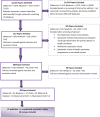Facilitators and barriers to quality of care in maternal, newborn and child health: a global situational analysis through metareview
- PMID: 24852300
- PMCID: PMC4039842
- DOI: 10.1136/bmjopen-2013-004749
Facilitators and barriers to quality of care in maternal, newborn and child health: a global situational analysis through metareview
Abstract
Objective: Conduct a global situational analysis to identify the current facilitators and barriers to improving quality of care (QoC) for pregnant women, newborns and children.
Study design: Metareview of published and unpublished systematic reviews and meta-analyses conducted between January 2000 and March 2013 in any language. Assessment of Multiple Systematic Reviews (AMSTAR) is used to assess the methodological quality of systematic reviews.
Settings: Health systems of all countries. Study outcome: QoC measured using surrogate indicators--effective, efficient, accessible, acceptable/patient centred, equitable and safe.
Analysis: Conducted in two phases (1) qualitative synthesis of extracted data to identify and group the facilitators and barriers to improving QoC, for each of the three population groups, into the six domains of WHO's framework and explore new domains and (2) an analysis grid to map the common facilitators and barriers.
Results: We included 98 systematic reviews with 110 interventions to improve QoC from countries globally. The facilitators and barriers identified fitted the six domains of WHO's framework--information, patient-population engagement, leadership, regulations and standards, organisational capacity and models of care. Two new domains, 'communication' and 'satisfaction', were generated. Facilitators included active and regular interpersonal communication between users and providers; respect, confidentiality, comfort and support during care provision; engaging users in decision-making; continuity of care and effective audit and feedback mechanisms. Key barriers identified were language barriers in information and communication; power difference between users and providers; health systems not accounting for user satisfaction; variable standards of implementation of standard guidelines; shortage of resources in health facilities and lack of studies assessing the role of leadership in improving QoC. These were common across the three population groups.
Conclusions: The barriers to good-quality healthcare are common for pregnant women, newborns and children; thus, interventions targeted to address them will have uniform beneficial effects. Adopting the identified facilitators would help countries strengthen their health systems and ensure high-quality care for all.
Keywords: Public Health.
Published by the BMJ Publishing Group Limited. For permission to use (where not already granted under a licence) please go to http://group.bmj.com/group/rights-licensing/permissions.
Figures
References
-
- United Nations Children's Fund. Levels & trends in child mortality: report 2011. Estimates developed by the UN Inter-agency Group for Child Morality Estimation. New York: United Nations Children's Fund, 2011
-
- The Maternal Mortality Estimation Inter-Agency Group (MMEIG). Trends in maternal mortality: 1990 to 2010. Geneva: World Health Organization, 2012
-
- Rajaratnam JK, Marcus JR, Flaxman AD, et al. Neonatal, postneonatal, childhood, and under-5 mortality for 187 countries, 1970–2010: a systematic analysis of progress towards Millennium Development Goal 4. Lancet 2010;375:1988–2008 - PubMed
-
- Hogan MC, Foreman KJ, Naghavi M, et al. Maternal mortality for 181 countries, 1980–2008: a systematic analysis of progress towards Millennium Development Goal 5. Lancet 2010;375:1609–23 - PubMed
-
- World Health Organization. World health statistics 2012. Geneva, Switzerland: World Health Organization, 2012
Publication types
MeSH terms
Grants and funding
LinkOut - more resources
Full Text Sources
Other Literature Sources


